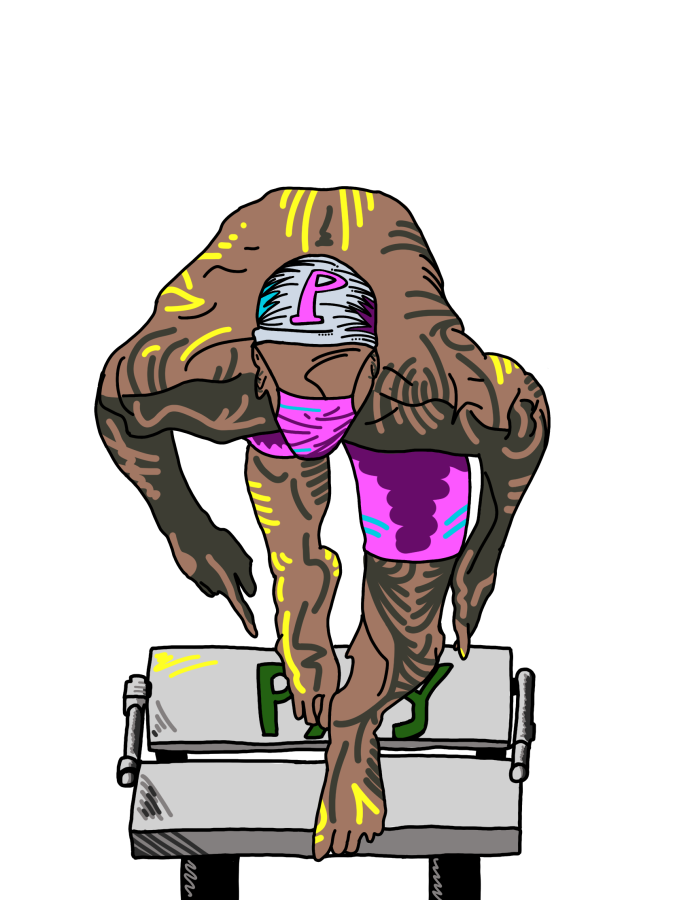When then-junior Diego Mazzon had his swim season cut short at the end of the 2019-2020 school year, he never expected that when he returned to captain the team this year, COVID-19 would still be haunting Paly swimming, shortening the season once again and temporarily putting training to a stand-still.
“I was pretty disappointed,” Mazzon said. “I think that in sports, a good season can have a big impact on one’s future. The season being cut short prevented me from that.”
Mazzon’s feelings echo those of many Paly athletes, and not just the ones who had their spring seasons cut short. COVID-19 closed gyms, stopped practices and shut down facilities. Students looking forward to playing fall and winter sports have been forced to wait until second semester, or the very end of first semester, to do so. Teams that were once close are now distant — literally.
However, recently, the Paly athletics department announced that it would begin preseason training — with heavy restrictions — on Sept. 14, an opportunity that many Paly sports have already jumped at.
As of now, boys and girls swimming, boys and girls water polo, boys lacrosse, football, boys and girls wrestling, boys and girls golf, boys and girls cross country, dance and cheer have all begun preseason training, all of which are required to follow county guidelines released in early September.
Masks and social distancing are front and center on the county’s guidelines for preseason training, but the degree to which that has affected athletes’ abilities to practice varies between sports.
Golf, for example, has hardly been affected by these guidelines. Junior golfer Sydney Sung said she feels lucky because golf, even before COVID-19, was basically a socially distant sport.
“Playing golf during the pandemic has been pretty easy because normally, we don’t get closer than six feet away anyway,” Sung said. “And, I can still practice as much as I did before the pandemic.”
Sports like wrestling and football, however, have not experienced the same luxury. From home workouts, to training with teammates on a wrestling mat in his backyard, to travelling to San Jose to get in actual, physical practice, junior Max Felter has been forced to find unique solutions to continue training and wrestling as wrestling rooms and clubs closed. Even so, he is uncertain whether he will even get a wrestling season this year.
“Wrestling will obviously be the last sport that gets to come back since it’s such a close contact sport,” Felter said. “I’m definitely unsure if we’ll get a season.”
Despite having begun preseason training at Paly, Paly wrestling coach Jonathan Kessler said the current state and county guidelines make proper training nearly impossible.
“You have to leave the state to get in competitions,” Kessler said. “You need to have a connection outside of school to partake in contact practices.”
Sports that land somewhere in between wrestling and golf in terms of the impact these guidelines have had, have found different ways to adapt. Dance, for example, has put the majority of its practices online, connecting over Zoom and training virtually. This, however, has come with its own share of drawbacks.
“Team bonding is definitely different,” dance coach Alanna Williamson said. “Normally, a lot of the bonding happens as dancers come into the studio and wait for practice to start.”
Another guideline that has proven difficult for some sports is that practices are capped at 14 athletes plus coaches, and the athletes within those cohorts can not rotate through other cohorts. This has presented a number of challenges for sports that practice in limited or shared spaces.
Take swimming, for instance. The large groups that once trained together are now limited to 14, and lanes that were once shared by four to five athletes can now only contain one. With a limited number of lanes and, by extension, a limited number of people that can train together, sometimes fewer than 14 people can practice.
In turn, this has led to shortened practices to create more practice times so as to accommodate all athletes. Add on top of that the fact that the swim team must share the pool with the water polo teams, and the team has begun turning to off-campus sites altogether.
A guideline that deterred many sports from even beginning preseason training is that sharing equipment was initially prohibited, including balls in ball sports. This caused some sports, such as volleyball and basketball, to postpone training until this guideline changed to allow for sharing of equipment between athletes.
This guideline has since been revised to allow for shared equipment, though ball sports are still limited in what and how they can practice.
For boys varsity lacrosse coach DJ Shelton, dealing with these limitations has been a matter of balancing the drawbacks and benefits.
“What kind of drills we can do are severely limited given the guidelines,” Shelton said. “However, the upside is that we can focus more on the fundamentals and basic conditioning, which honestly, is all anyone needs to focus on this early. ”
The final guidelines for preseason training are that athletes are now required to bring their own water, locker rooms are closed, bathrooms are limited to one person at a time and athletes must submit a self-screening health at every practice.
Even amidst these uncertain times, Mazzon has managed to do what many athletes strive for, finding good in the situation.
“I think COVID has motivated me to try harder,” Mazzon said. “Overall, I think it was a blessing in disguise.”



